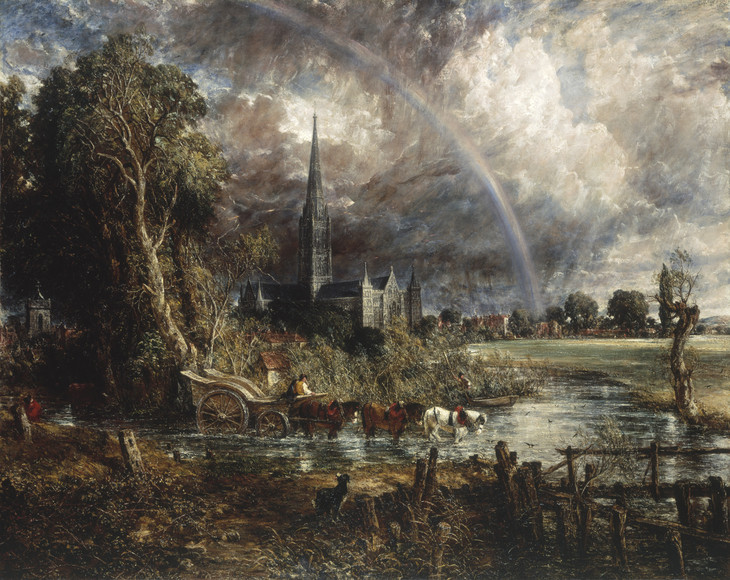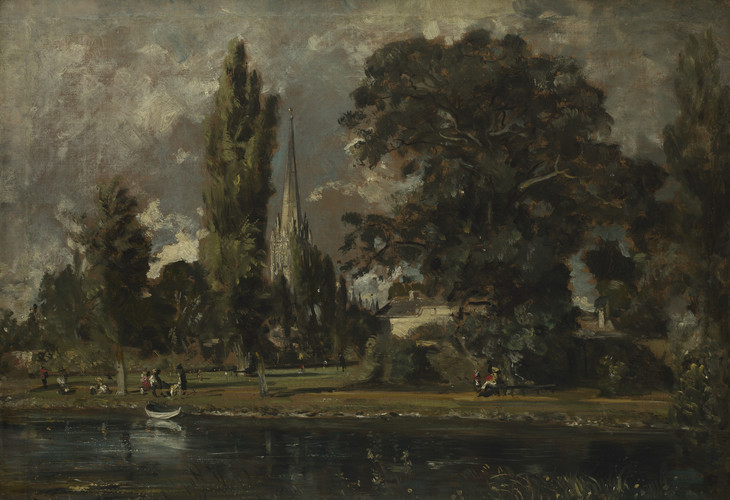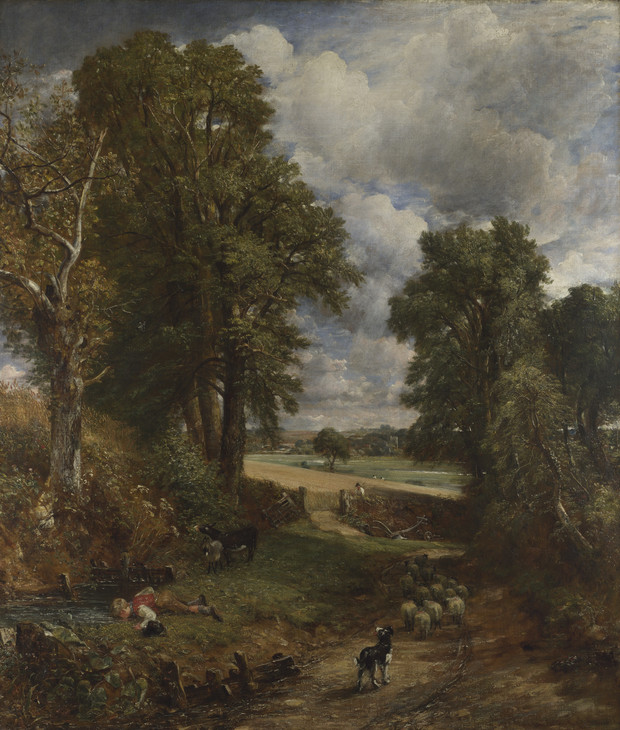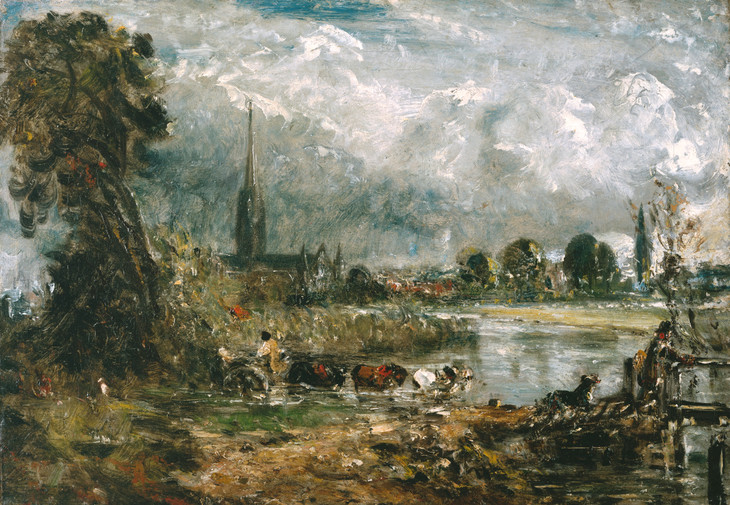Sublime Nature: John Constable’s Salisbury Cathedral from the Meadows
Anne Lyles
A small oil sketch by John Constable of a view of Salisbury Cathedral from the Meadows (N01814, fig.1) is in Tate’s collection. It is a modest work, painted around 1829–30 in the studio when Constable was planning the composition for a much larger painting which he intended to exhibit at the Royal Academy. The final work, the large Salisbury Cathedral from the Meadows (fig.2), on loan to the National Gallery, was shown by Constable at the Academy in 1831, and is today one of his most famous late paintings.

John Constable
Salisbury Cathedral from the Meadows 1831
Oil on canvas
1518 x 1899 mm
On loan to the National Gallery from a private collection
© The National Gallery, London
Fig.2
John Constable
Salisbury Cathedral from the Meadows 1831
On loan to the National Gallery from a private collection
© The National Gallery, London
In the finished picture, by contrast, we are instantly struck by the full impact of a raging storm, or at least what must be a passing storm given the inclusion of a large rainbow arching above the cathedral. The effect here is much more dramatic and powerful than in the sketch. The clouds are billowing and turbulent, the contrast of light and shade is more exaggerated, and there is even a streak of lightning above the cathedral roof. We feel a sense of unease and think in terms of awe, grandeur – the picture is actually one of Constable’s largest – as well as of something more intangible, majestic, even ethereal. In short, we have now entered the territory of the sublime.
For some readers this may be a surprise but Constable is not an artist whose work is generally associated with concepts of the sublime. Rather, his paintings are usually spoken of in terms of their naturalism, something he himself and his first biographer, C.R. Leslie, did a great deal to promote.2 When his work is not described as naturalistic, other terms tend to be used such as ‘pastoral’ or perhaps ‘picturesque’. It is rarely, if ever, defined as ‘sublime’. A closer look at Salisbury Cathedral from the Meadows should, however, encourage us to reconsider.
What, if anything, did Constable himself think about theories of the sublime? We are able to get some idea of his thoughts on the matter as among his extensive surviving correspondence there is a letter written quite early in his career, in 1814, to his then fiancé, Maria Bicknell. He told her he had been reading Archibald Alison’s book on The Nature and Principles of Taste (1790), which he said he much preferred to ‘Mr Burke’s’ – that is Edmund Burke’s Philosophical Enquiry into the Origin of our Ideas of the Sublime and Beautiful (1757). In comparing the two, he told Maria he found Alison’s book ‘the more just and its conclusions more sublime’. He particularly liked the last essay, ‘On the Final Cause and of the Constitution of our Nature’, which he rated as ‘by far the most beautifull thing ... I ever read’ as Alison ‘considers us as endowed with minds capable of comprehending the “beauty and sublimity of the material world” only as the means of leading us to religious sentiment’.
In fact, Constable only occasionally used the word ‘sublime’ in his writings, whether as a noun or in an adjectival sense; it is significant that when he does it is almost always in a religious or spiritual context. He inherited profound Christian values from his pious parents and remained a lover of devout literature throughout his life. Indeed, he was familiar with the sort of contemporary literature, such as William Paley’s Natural Theology (1802), which argued that the sense of order and uniformity inherent in the natural world was evidence of a divine purpose. It is thus hardly surprising to find Constable in 1814 preferring Alison to Burke, and concluding that the experience of the beauty of nature generates a train of associations in the human mind that leads to the contemplation of higher, spiritual values.
It is also important that Constable’s art is fundamentally autobiographical in the sense that he tended only to paint places intimately connected with the areas where he lived or the friends he knew and visited; this also serves to heighten the associative value of his pictures. For example, the ‘six-foot’ landscapes he painted and exhibited at the Royal Academy in the 1820s, featuring views of the River Stour, are imbued with the memories of his happy boyhood years in Suffolk, sometimes to the point of nostalgia. In a similar way, his Salisbury Cathedral from the Meadows pays indirect tribute to his much valued friendships with two people closely associated with the city and its cathedral: Bishop John Fisher, an early supporter of his work, and, in particular, Archdeacon John Fisher, the bishop’s nephew and Constable’s greatest friend and confidant, especially in the years following his wife’s death.

John Constable
Salisbury Cathedral and Leadenhall from the River Avon 1820
Oil on canvas
527 x 770 mm
Salting Bequest to the National Gallery 1910
© The National Gallery, London
Fig.3
John Constable
Salisbury Cathedral and Leadenhall from the River Avon 1820
Salting Bequest to the National Gallery 1910
© The National Gallery, London
The two men were ardent supporters of the Anglican Church. Its future was much discussed between them around this date; unsurprising given the momentum, indeed the increasing agitation, towards the passing of a Reform Bill, finally granted royal assent in June 1832, which served to widen the electorate. To Constable and Fisher any change in the franchise could only threaten the position of the established Church which they regarded as already weakened by the passing of the Catholic Emancipation Act in 1829. The large Salisbury Cathedral painting is often interpreted in the light of this political and religious turmoil, as if expressive of Constable’s fears about the future of the Church. While an element of Constable’s personal anxiety about these developments is undoubtedly an aspect of the picture’s ‘meaning’, it would be overly simplistic to read it purely on this literal level, especially as Constable himself was critical of the use of overt symbolism in other artists’ work. For example, in a lecture he delivered around this very date he found fault with a picture, The Jewish Cemetery, painted by the seventeenth- century Dutch artist Jacob van Ruisdael, in which certain elements of the landscape were designed to be read as an allegory of the life of man. He concluded that Ruisdael was here attempting ‘to tell that which is outside the reach of art’.
In fact, it seems likely that another perhaps more significant message lies behind the painting: one very personal to the artist himself. Although Constable is known to have made meteorologically accurate studies of rainbows around this time, the bow in the Salisbury Cathedral painting is not one of these. It almost certainly therefore has symbolic value as a sign of hope associated with God’s covenant with Noah accompanying the receding of the waters after the Deluge, as narrated in the Book of Genesis, chapters 6–9. Indeed, this symbolic reading is reinforced by the lines of verse, from James Thomson’s poem The Seasons (1727), which Constable selected for inclusion alongside the painting’s title in the Royal Academy catalogue, which makes reference to the ‘sublime’ swelling of an ‘interminable’ sky:
As from the face of heaven the scatter’d clouds
Tumultous rove, th’interminable sky
Sublimer swells, and o’er the world expands
A purer azure. Through the lightened air
A higher lustre and a clearer calm
Diffusive tremble; while, as if in sign
Of danger past, a glittering robe of joy,
Set off abundant by the yellow ray,
Invests the fields, and nature smiles reviv’d.3
Tumultous rove, th’interminable sky
Sublimer swells, and o’er the world expands
A purer azure. Through the lightened air
A higher lustre and a clearer calm
Diffusive tremble; while, as if in sign
Of danger past, a glittering robe of joy,
Set off abundant by the yellow ray,
Invests the fields, and nature smiles reviv’d.3
It is surely no coincidence, also, that the arc of the rainbow ends at Leadenhall, the home of the very person, Archdeacon Fisher, who had offered Constable such steadfast support in the years after his wife’s death.
Although there is no direct evidence to confirm this, it seems likely that Constable’s Christian faith might have wavered during this difficult period of his life. If so, the inclusion of the rainbow might well also be symbolic of a sense of his spiritual reconciliation following a period of adversity. It is surely significant in this respect that at the top of the cathedral spire a crowning cross stands out boldly in front of the one bright spot in the turbulent sky. Constable had once written to Maria – back in 1812 when their courtship was forbidden by her family – that ‘adversity ... refines the mind and encreases his understanding to love God and his works’. By 1834 he could acknowledge to a friend that although he now painted ‘continual storms ... still the “darkness” is majestic’.

John Constable
The Cornfield 1826
Oil on canvas
1430 x 1220 mm
Presented to the National Gallery by subscribers, including Wordsworth, Faraday and Sir William Beechey, 1837
© The National Gallery, London
Fig.4
John Constable
The Cornfield 1826
Presented to the National Gallery by subscribers, including Wordsworth, Faraday and Sir William Beechey, 1837
© The National Gallery, London
Indeed, Salisbury Cathedral was originally considered as the ideal example to represent Constable’s art when a group of subscribers came together shortly after his death in 1837 to purchase a picture to present to the National Gallery in his memory. Fearing, however, that it might be regarded as too difficult an example for the public to appreciate fully, especially in its expressive handling of paint, a more idyllic, pastoral subject was chosen instead, The Cornfield 1826 (fig.4), ironically one in which Constable confessed to having added to it more ‘eye-salve’ than usual as a concession to popular taste. So it was that the first picture by Constable to enter the national collection was one which served to create and then to perpetuate the idea of his work as belonging to a sort of blend of the natural with the pastoral rather than the sublime or even the beautiful. Had Salisbury Cathedral from the Meadows been presented to the National Gallery instead, it is entirely possible that we might now have a very different, or at least a more rounded, view of Constable’s complex art.
Notes
Anne Lyles is Curator (18th and 19th Century British Art), Tate Britain.
How to cite
Anne Lyles, ‘Sublime Nature: John Constable’s Salisbury Cathedral from the Meadows’, in Nigel Llewellyn and Christine Riding (eds.), The Art of the Sublime, Tate Research Publication, January 2013, https://www

